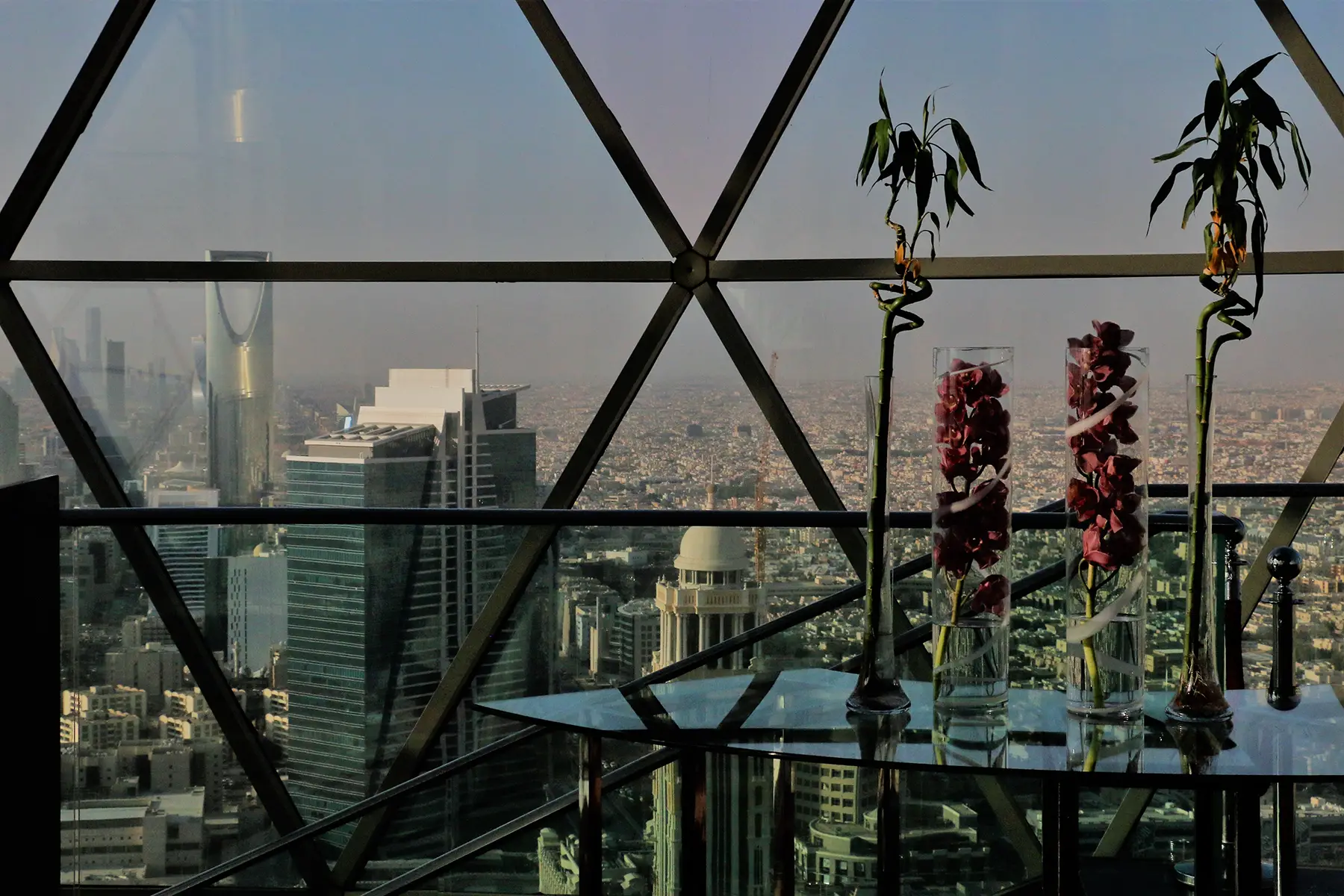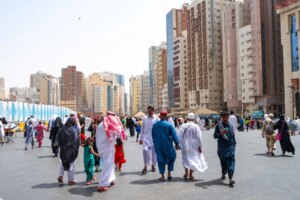Saudi Arabia is mostly made up of a desert plateau and features the intense summers and slightly cooler winters that come with this topography. But centuries of experience have allowed the Kingdom to adapt well to its climate. Here’s everything you need to know about dressing appropriately and finding activities to do; according to the climate and seasons in Saudi Arabia.
This article covers the following topics:
The climate in Saudi Arabia
Saudi Arabia is surprisingly vast, however with most of the country being a desert-like plateau, weather conditions are usually fairly stable. The main climate differences can be felt between the coastal areas and the interiors. In most of the country, summers are hot and dry; winters are mild, on the other hand, with temperatures dropping at night, and rain can be expected at this time.
The Kingdom’s capital, Riyadh, experiences temperamental winters. Warm days turn into frigid nights, and summers are extreme with temperatures peaking at 47 degrees. However, low humidity offers some comfort. In the far north mountains, winters are cold and you might even experience snow. Meanwhile, in the coastal areas around the Red Sea and the Persian Gulf, the climate remains warm and sultry all year.
Regional climate averages in Saudi Arabia
January is the depth of what passes for winter in Saudi Arabia, however, conditions can vary wildly in different regions. At this time of year, you could find rain and temperatures dropping as low as 6 degrees Celsius during the night in Mada’in Saleh. Meanwhile, Jeddah might experience tropical thunderstorms and balmy days, with temperatures reaching 30 degrees Celsius.

Of course, this is the country’s rainy season. Most rainfall occurs between November and April. During this period, the central plateau, including Riyadh, sees a yearly average of 111mm. Meanwhile, drier parts of the country, such as Medina, only receive around 41mm.
Summers in Saudi Arabia are unstintingly intense. Average temperatures hover around 40 degrees Celsius, although the barometer has been known to peak at 50 degrees Celsius. The season is also unfailingly dry, with no rain and only moderate humidity. Although the summers are similar to those experienced in neighboring countries such as Oman, Jordan, and Iraq, the winters tend to be warmer. This is due to Saudi Arabia’s geographical location; it is sheltered within the Red Sea and Persian Gulf and therefore does not benefit from the cool coastal breezes that other countries enjoy.
Although the amount of sunshine doesn’t vary enough between the seasons to warrant daylight saving measures, there are generally longer days in summer and shorter days in winter. Most of the Kingdom receives between 9 and 12 hours of sun each day. In extreme areas, however, this can dip to as little as 7 hours and increase to as much as 14. As you would expect in the desert climate of Saudi Arabia, snowfall is extremely rare here, however, in the very far north of Turaif, and some altitudinous mountain regions, snow is a possibility if conditions are right.
Summer in Saudi Arabia
Long and unforgiving Saudi summers are not for the fainthearted. From May onwards, temperatures soar from around 30 degrees Celsius and peak at around 45 degrees in August. There is very little rainfall to cool things down, but thankfully, there isn’t too much humidity, either.
What to wear in summer
If you are going to brave summers in Saudi Arabia, the trick will be finding a way to cover up and respect the local culture while trying to stay cool. Lightweight clothes in natural fibers are recommended, but you will want to keep a wrap or cardigan handy; air-conditioning can be positively glacial indoors as residents try to beat the heat. Saudi Arabia has very conservative dress codes so to ensure that you are appropriately attired, it is best to remain covered at all times; this applies to both genders, too. Women can only have their faces and hands exposed, so it may be more comfortable to wear light abayas like the locals. While headscarves are technically optional, you may attract negative stares and disapproval if you choose to go without. Attitudes towards footwear, however, are more liberal, so feel free to opt for open-toe styles.

Popular summer activities
Despite the uncomfortable heat, it is easy to seek relief during the intense summer in Saudi Arabia. Riyadh’s Snow City is popular for activities such as skiing and sledding. Many malls, including Royal, Othaim, and Hayat, also offer ice-skating. In-the-know locals head to swanky hotels like the Marriott Diplomatic Quarter, Luthan Hotel and Spa, and the Burj Rafal to lounge by the pool. If you are looking to escape the city, though, you can rent an istiraha (rest house) with a pool on the city fringes, or venture to the highlands of Al Taif and Al-Madinah.
Summers are peak holiday season, so you will have lots of time to enjoy all of these summer activities. The season is bookended by the Eid al-Fitr holiday in June, and Eid al-Adha in August. Before going back to work or school at the end of the summer, residents celebrate Muharram – the Muslim New Year – at the end of August. Find out more about Public holidays in Saudi Arabia.
Winter in Saudi Arabia
Winter in Saudi Arabia peaks between December and January, however, it can extend up to a month either side. Average temperatures during the season are a comfortable 20 degrees Celsius, but in certain regions, it can drop closer to zero degrees by night; January is definitely considered the coldest month. Rainfall reaches a high during the winter months, although this can vary in different parts of the country. Generally, the central plateau, including the capital of Riyadh, has the heaviest downpours. Snow is rare, but some areas, such as mountainous Jiraz, Tabuk, or Jabal al-Lawz, can experience a light dusting.
What to wear in winter
Since temperatures can vary, you will want a range of clothing on hand. Layers are always a good idea so you can add or remove them as the weather demands. T-shirts are usually fine during the daytime, but you may want a light jacket or sweater at night. In the far north or western mountains, down jackets, scarves, and boots will come in useful for battling the more frigid conditions. For women, this is the ideal time to choose thicker abayas (and layer up underneath) and pick thicker scarves to wrap up your hair.
Popular winter activities
With winter being the most temperate season in Saudi Arabia, this is the perfect time to get outdoors. Many locals choose to use the winter to indulge in desert activities, so head out to Al-Nafud or Rub’ al Khali for horse-riding, sandboarding, and hiking. For those staying in Riyadh, horse-racing at the King Abdulaziz Race Track is a popular weekend pastime. Winters are all about weekend fun since there are no public holidays during the season. Schools close for two weeks in January, though, so many residents choose to take family trips during this time.

Spring in Saudi Arabia
Saudi Arabia doesn’t have much of a spring, but what passes for this transitional season rolls by all too quickly between March and April. Temperatures rise sharply over the two months, hitting the mid-30s by the end of the season. Don’t expect any rain during this time.
What to wear in spring
With the weather heating up quickly, spring is the time to transition your wardrobe to summer essentials. Put away the jacket and cardigans and break out loose, light shirts and flowy trousers. This is the moment to wear cotton and linen garments. While styles get a little more relaxed during this period, remember to maintain a conservative approach towards how you dress.
Popular spring activities
Despite its truncated length, spring is festival season in Saudi Arabia and you will find a plethora of events to attend such as the Yanbu Flower Festival (the country’s answer to London’s Chelsea Flower Show), the Riyadh International Book Fair, and multiple golf tournaments at the local links. This is also a great time to head to the desert, visit seasonal lakes like Kharrarah, and hike to the Edge of the World. The Kingdom’s vegetation comes to life in spring, so this is the best time to explore the flora (roses specifically) and fauna in the hills of Ta’if, Madinah, and Jeddah. You may even be able to nose around and find some of the famous Saudi black truffles which come into season during this period.
Autumn in Saudi Arabia
Like spring, autumn in Saudi Arabia is short and sweet; usually spanning the months of September and October.

From mid-September, the weather begins to cool off, but relief from the intense desert heat only comes in October when daily averages drop to around 26 degrees Celsius. The tiny – almost negligible – rainfall that sometimes occurs during this period also helps take the edge off.
What to wear in autumn
In terms of clothing, it is advisable to keep things simple and go for the same kind of transitional outfits you would wear during the springtime; i.e., loose, light shirts and flowy trousers, as well as cotton and linen wear. It is also a good idea to keep outer layers handy towards the end of the season.
Popular autumn activities
This is also a time for celebration in Saudi Arabia. The country hosts several annual events during this period, including the Hala Jeddah Festival. The official National Day – Unification of the Kingdom Day – is held on September 23 every year to celebrate the country’s founding in 1932. Although this is traditionally a quiet observance, the last few years have seen the day take on a more festive atmosphere with fireworks and public acknowledgments.
Holiday seasons in Saudi Arabia
Summer is the main holiday season in Saudi Arabia. With a three-month school break coinciding with blisteringly high temperatures, many residents – especially expat families – take the opportunity to venture overseas for an extended break.
At other points during the year, travel peaks in line with the school holidays. Expect to see a mass exodus from Saudi Arabia for two weeks at the beginning of January, and another two weeks at the end of April or beginning of May; this is when the Eid al-Fitr festival takes place.
King Khalid International Airport serves Riyadh; this is the main entry point for international arrivals and stopovers in the Kingdom. There are five terminals here, although only two are currently served by international flights; both get busy around the holiday period. Passenger arrivals have more than doubled over the last 10 years to more than 26 million entries in 2018; therefore, things are only going to get more chaotic.





